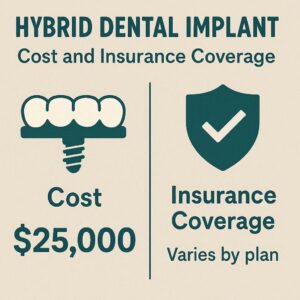The Complete Guide to Hybrid Dental Implant Cost and Insurance Coverage
The pursuit of a confident, fully functional smile is a journey many embark on when faced with extensive tooth loss or decay. For decades, the options were limited—uncomfortable, bone-loss-inducing traditional dentures or the complex, lengthy process of receiving individual implants for each missing tooth. However, a revolutionary solution has emerged, fundamentally changing the landscape of restorative dentistry: the hybrid dental implant prosthesis, often known as the “All-on-4” or “Teeth in a Day” procedure. This advanced technique combines the stability of dental implants with the full-arch replacement of a denture, creating a permanent, non-removable set of teeth that look, feel, and function like your own.
Yet, for all its life-changing benefits, the single most significant question for most patients is: “How much does it cost, and will my insurance cover it?” The financial aspect of hybrid dentures can be daunting, often representing a substantial investment in one’s health and quality of life. The landscape of dental insurance, with its complex clauses, annual maximums, and varying coverage tiers, adds another layer of confusion. This comprehensive guide is designed to be your definitive resource. We will dissect the cost components of hybrid dentures, demystify the intricacies of insurance coverage, and provide a roadmap to navigating the financial path to your new smile. We will move beyond generic information, offering exclusive insights and strategies to empower you to make an informed decision.

1. Understanding the Hybrid Dental Implant Procedure: More Than Just “False Teeth”
To truly appreciate the cost of hybrid dentures, one must first understand what they are and the sophisticated technology and expertise required to place them. This is not a simple, off-the-shelf product; it is a custom-crafted, biomechanically engineered restoration.
What Exactly is a Hybrid Denture?
A hybrid denture, in its simplest definition, is a single, solid piece of prosthetic teeth made from high-performance acrylic or zirconia, which is permanently secured to a series of dental implants embedded in the jawbone. Unlike traditional dentures that rest on the gums and are prone to slipping, hybrid dentures are screw-retained onto the implants, making them completely stable and non-removable by the patient. The name “hybrid” comes from its design, which is a cross between a fixed bridge and a removable denture, offering the best of both worlds: the permanence of a bridge and the full-arch replacement of a denture.
The prosthesis is designed with a small gap between its underside and the gum tissue, allowing for easy cleaning and maintenance. Patients care for them much like natural teeth, with regular brushing and the use of floss threaders or water flossers to clean underneath.
The All-on-4® Technique: The Gold Standard
While “hybrid denture” describes the prosthesis itself, the “All-on-4” treatment concept, pioneered by Nobel Biocare, is the most renowned surgical protocol for its placement. This innovative technique allows for a full-arch of teeth to be supported by just four strategically placed implants.
The brilliance of the All-on-4 method lies in its angulation. The two posterior implants are tilted at angles of up to 45 degrees, which allows them to utilize available bone at the back of the jaw, often avoiding the need for complex and costly bone grafting procedures. This strategic placement also provides a longer “cantilever” support, enabling the four implants to withstand the chewing forces of a full set of teeth. It is a testament to biomechanical engineering, maximizing support while minimizing the number of implants required.
The Clinical Procedure: A Step-by-Step Journey
The journey to a hybrid denture is a collaborative process between the patient, the surgical specialist (often an oral surgeon or periodontist), and the restorative dentist or prosthodontist.
-
Comprehensive Consultation and Diagnosis: This initial appointment is the most critical. It involves a thorough oral examination, a review of medical history, and advanced 3D imaging (CBCT scans). The CBCT scan provides a detailed, three-dimensional view of the jawbone, allowing the surgeon to assess bone density, volume, and the precise location of vital structures like nerves and sinuses. This is when the treatment plan is formulated, and a determination of candidacy is made.
-
Treatment Day: Surgery and Immediate Loading: On the day of the procedure, any remaining failing teeth are gently removed. The jawbone is then prepared, and the four (or more) dental implants are placed according to the pre-planned positions. Following implant placement, the custom-crafted temporary hybrid denture is attached to the implants. This “Teeth in a Day” aspect is profoundly impactful, as patients leave the office with a fixed, functional set of teeth on the same day as their surgery.
-
The Healing and Osseointegration Phase: Over the next three to six months, the magic of biology takes over. A process called osseointegration occurs, where the jawbone biologically fuses with the titanium surface of the implants, creating an anchor as strong as a natural tooth root. During this time, the temporary denture allows for normal eating and speaking while the gums heal and settle into their final shape.
-
Delivery of the Final Prosthesis: Once healing is complete, the temporary denture is removed, and the final, permanent hybrid denture is attached. This final prosthesis is crafted from more durable and aesthetic materials, such as layered acrylic or monolithic zirconia, and is designed to last for decades with proper care.
Candidacy for Hybrid Dentures
Most adults who have lost, or are about to lose, all or most of their teeth in one or both arches are potential candidates. Key factors include:
-
General Health: Patients must be in good general health. Uncontrolled diabetes, immunosuppression, or a history of radiation to the jaw can affect healing.
-
Bone Quantity and Quality: While the All-on-4 technique often avoids bone grafting, there must still be a sufficient amount of bone to support the implants. The CBCT scan is crucial for this assessment.
-
Oral Hygiene Commitment: While the prosthesis is fixed, meticulous oral hygiene is non-negotiable to prevent peri-implantitis, a destructive inflammatory process affecting the tissues around the implants.
-
Lifestyle Factors: Smoking significantly increases the risk of implant failure and can be a contraindication for some providers.
2. Deconstructing the Cost of Hybrid Dentures: Where Does Your Investment Go?
Seeing a single total cost for hybrid dentures can be overwhelming. However, this fee is an amalgamation of numerous complex components, each representing a critical part of the treatment’s success. Let’s break down this investment.
The Breakdown of a Hybrid Denture Quote
A typical cost for a single arch (upper or lower) of hybrid dentures in the United States can range from $15,000 to $40,000 or more. For two arches, the cost can be $30,000 to $80,000+.
This wide range exists due to the variables we will explore. The total fee generally encompasses two main phases: the surgical phase and the prosthetic (restorative) phase.
The Surgical Phase: Implants, Abutments, and Expertise
This phase constitutes a significant portion of the cost and involves the work of the surgical specialist.
-
Dental Implants: The implants themselves are precision-machined, medical-grade titanium (or sometimes zirconia) components. The brand and type of implant can affect the cost. Established, research-backed brands like Nobel Biocare, Straumann, and Zimmer Biomet often command a premium due to their proven long-term track records and extensive research.
-
Surgical Fees: This covers the immense skill, training, and experience of the oral surgeon or periodontist. Placing implants, especially with the angled precision required for the All-on-4 technique, is a highly specialized skill. This fee also includes the cost of the surgical facility, sterile equipment, and surgical staff.
-
Abutments: These are the connecting pieces that link the implant to the denture. They can be standard or custom-milled for optimal fit and aesthetics. Custom titanium abutments add to the cost but provide a superior result.
The Prosthetic Phase: The Denture Itself – Materials and Lab Fees
This phase is managed by the restorative dentist and the dental laboratory technician.
-
Temporary Hybrid Denture: The immediate, temporary denture placed on the day of surgery is a custom-made prosthesis. It is designed to be functional and aesthetic during the healing period but is made from less durable materials than the final version.
-
Final Hybrid Denture: This is the long-term restoration. The material choice here is a major cost driver.
-
Acrylic with Composite Teeth: This is a more economical option. The denture is made from a high-impact acrylic resin with composite teeth embedded in it. Over years of use, the acrylic can wear, and the teeth can stain. The lifespan is typically 5-10 years before needing a “reline” or replacement.
-
PMMA (Polymethyl methacrylate): A newer, highly cross-linked polymer that is much more durable and stain-resistant than traditional acrylic. Often milled as a single piece, it minimizes the risk of tooth wear or debonding.
-
Zirconia: This is the premium material. Monolithic zirconia is an incredibly strong, ceramic material that is highly aesthetic, exceptionally durable, and virtually impervious to staining and wear. It is biocompatible and helps resist plaque accumulation. A zirconia hybrid denture is typically twice the cost of an acrylic one but can last a lifetime with proper care. The fabrication process is also more complex, requiring advanced CAD/CAM technology and significant laboratory time.
-
-
Laboratory Fees: The dental lab that fabricates the prosthesis charges significant fees, especially for a complex, custom-made restoration like a hybrid denture. The technician’s artistry is what creates the natural-looking aesthetics of the final smile.
Ancillary Costs: Diagnostic Imaging, Bone Grafting, and Sedation
These are often “add-on” costs that may or may not be included in an initial quote.
-
Diagnostic Imaging: A panoramic X-ray is standard, but the essential CBCT 3D scan carries an additional cost, typically a few hundred dollars.
-
Bone Grafting/Sinus Lift: Even with the All-on-4 technique, some patients may require minor bone grafting to ensure ideal implant stability. This can add $500 to $3,000 per site to the total cost.
-
Anesthesia/Sedation: While local anesthesia is standard, many patients opt for IV sedation for comfort during the lengthy procedure. This can cost between $500 and $1,500 per arch.
Geographic Variation: How Your Location Influences Price
The cost of living and the average overhead for dental practices vary dramatically across the country. A hybrid denture in a major metropolitan area like New York City or San Francisco will almost always be more expensive than the same procedure in a suburban or rural area in the Midwest. It is not uncommon for prices to differ by 20-30% based solely on geography.
3. Dental Insurance and Hybrid Dentures: A Complex Relationship
Navigating dental insurance for a major procedure like hybrid dentures requires a clear understanding of its fundamental limitations and strategic opportunities.
Why Most Insurance Doesn’t “Cover” the Full Cost
The primary reason is the annual maximum. Most dental insurance policies have a yearly cap on benefits, typically ranging from $1,000 to $2,000. This amount was set decades ago and has not kept pace with inflation or the advancement of dental procedures. A hybrid denture costing $25,000 per arch far exceeds this maximum, meaning insurance will only ever contribute a small fraction of the total cost. It’s also crucial to understand that insurance companies are in the business of managing risk and cost, not necessarily in ensuring you receive the best possible care. They often define coverage based on the “least expensive alternative treatment” (LEAT) clause, which would be a traditional removable denture.
Understanding Annual Maximums and Their Limitations
Your annual maximum resets every calendar year. For a multi-phase treatment like hybrid dentures, this can be strategically leveraged. For instance, the surgical phase (extractions, implant placement) could be scheduled in November, and the prosthetic phase (delivery of the final denture) could be scheduled in January of the following year. This allows you to utilize two separate annual maximums, potentially doubling the insurance contribution. This requires precise coordination with your dental team.
Deconstructing Your Policy: What Parts Might Be Covered?
While the hybrid denture itself may not be fully covered, insurance will often cover the individual components of the procedure under different categories of benefits, subject to deductibles, co-pays, and waiting periods.
-
Diagnostic and Preventive (Usually 100% Covered): The initial exam and panoramic X-ray are often fully covered. The CBCT scan may be partially covered if deemed medically necessary.
-
Basic Procedures (Usually 70-80% Covered): Extractions of non-restorable teeth often fall into this category.
-
Major Procedures (Usually 50% Covered): This is where you might see some coverage. Dental implants are increasingly being recognized as a major procedure. The surgical placement of the implants and the associated abutments may be covered at the 50% rate. The final denture prosthesis, however, might be classified as a “bridge” and also covered at the 50% rate, but only up to the cost of a traditional partial or full denture—the insurance company will not pay 50% of a $15,000 zirconia denture, but rather 50% of what they deem a “reasonable and customary” cost for a denture, which is often a fraction of the actual cost.
Pre-authorization: The Critical Step Before Treatment
Before committing to treatment, you must insist that your dental provider submits a pre-authorization or pre-determination to your insurance company. This is a formal request outlining the proposed treatment plan and associated codes. The insurance company will then respond in writing, detailing exactly what benefits they will pay and what your out-of-pocket responsibility will be. This document is your financial blueprint and protects you from unexpected denials after the work is completed.
4. Financing Your New Smile: Strategies Beyond Traditional Insurance
Given the limitations of insurance, most patients utilize a combination of financing options to manage the cost.
In-House Dental Membership Plans
Many progressive dental practices offer their own in-house membership or savings plans. For an annual fee (e.g., $300-$600 for a family), patients receive discounts on treatments, including major procedures like implants and hybrid dentures. These plans bypass insurance entirely and can offer savings of 10-20% off the standard fee.
Third-Party Medical/Dental Financing
Companies like CareCredit and LendingClub Patient Solutions are specifically designed for healthcare expenses. They work like credit cards but often feature promotional periods with 0% interest if the balance is paid in full within a specified time (e.g., 6, 12, 18, or 24 months). This is an excellent option for those who can manage monthly payments and pay off the balance before the promotional period ends, as deferred interest can be substantial if not paid in time.
Flexible Spending Accounts (FSAs) and Health Savings Accounts (HSAs)
These are powerful tax-advantaged tools.
-
FSA: Allows you to set aside pre-tax dollars from your paycheck for medical expenses. The key feature is “use-it-or-lose-it,” so you must plan your contributions carefully for the year you plan to have treatment.
-
HSA: Available with high-deductible health plans, HSAs also use pre-tax dollars, but the funds roll over year after year and can be invested. You can strategically save in an HSA for several years to fund a future procedure like hybrid dentures, effectively reducing the cost by your marginal tax rate.
Dental School Clinics: A Cost-Effective Alternative
For the budget-conscious patient, treatment at a university dental school can reduce costs by 30-50%. The work is performed by dental residents or senior students who are closely supervised by experienced, licensed faculty professors. The trade-off is that the process can be significantly slower than in a private practice.
5. A Comparative Look: Hybrid Dentures vs. Alternative Solutions
To understand the value of hybrid dentures, one must look at the long-term financial and quality-of-life picture compared to the alternatives.
Cost-Benefit Analysis: Long-Term Value of Hybrid Dentures
While the upfront cost of hybrid dentures is high, it is often a one-time investment for a permanent solution. When viewed over 20 years, the cost-per-year becomes much more reasonable.
The Hidden Costs of Traditional Dentures
Traditional dentures have a much lower initial cost ($1,500-$3,000 per arch), but they come with a lifetime of ongoing expenses and hidden costs:
-
Bone Resorption: Without implant stimulation, the jawbone shrinks over time. This causes dentures to become loose and ill-fitting.
-
Denture Adhesives: A recurring monthly expense.
-
Denture Relines: Required every 1-2 years to refit the denture to the changing gums, costing $300-$500 each time.
-
Denture Replacement: Necessary every 5-7 years due to wear and bone loss, costing another $1,500-$3,000 each time.
-
Associated Health Costs: Poor nutrition from inability to eat properly, loss of self-esteem, and social anxiety.
The following table illustrates a 20-year comparative cost analysis for a single arch:
20-Year Comparative Cost Analysis (Single Arch)
| Cost Component | Hybrid Denture (Acrylic) | Hybrid Denture (Zirconia) | Traditional Denture |
|---|---|---|---|
| Initial Cost | $20,000 | $30,000 | $2,500 |
| Relines (Every 2 yrs @ $400) | $0 | $0 | $4,000 |
| Replacements (Every 7 yrs) | One replacement @ $7,500 | $0 (Likely no replacement) | Two replacements @ $2,500 each |
| Adhesives/Cleaning ($20/mo) | $0 | $0 | $4,800 |
| Bone Grafting (Future) | $0 (Bone preserved) | $0 (Bone preserved) | Potentially $3,000+ |
| Estimated 20-Year Total | $27,500 | $30,000 | $17,800 |
Note: This table is a simplified estimate. It does not assign a monetary value to the superior quality of life, nutrition, confidence, and bone preservation offered by hybrid dentures, which for most patients is the deciding factor.
6. Case Study: A Real-World Financial Breakdown
Patient: John, a 62-year-old needing a full upper arch restoration.
Treatment Plan: All-on-4 hybrid denture with a PMMA temporary and a final zirconia prosthesis.
Total Quote: $32,000
Insurance Breakdown (after Pre-authorization):
-
Covered at 100%: Exam & Panoramic X-ray – $250 (No out-of-pocket)
-
Covered at 80%: Extractions (8 teeth) – $1,600 -> Insurance paid $1,280 | John paid $320
-
Covered at 50%: Implant Surgery (4 implants) – $12,000 -> Insurance paid $1,000 (hit annual max) | John paid $11,000
-
Covered at 50%: Final Zirconia Denture – $15,000 -> Insurance paid $1,000 (new year’s max) | John paid $14,000
-
Not Covered: CBCT Scan, Sedation, Custom Abutments – $3,150 (John’s responsibility)
John’s Total Out-of-Pocket: $320 + $11,000 + $14,000 + $3,150 = $28,470
Total Insurance Contribution: $250 + $1,280 + $1,000 + $1,000 = $3,530
John used $5,000 from his HSA and financed the remaining $23,470 with CareCredit at 0% interest for 24 months, resulting in manageable monthly payments of ~$978.
7. Conclusion: Investing in a Lifetime of Confidence
The journey to a hybrid denture is a significant investment, not merely in a dental device, but in long-term oral health, overall well-being, and self-confidence. While the initial cost is substantial, understanding its components demystifies the price tag and reveals the value in the materials, technology, and expertise involved. Navigating dental insurance requires a strategic approach, focusing on maximizing benefits for individual components rather than expecting full coverage. By exploring financing options like HSAs and medical credit cards, and by viewing the cost through a long-term lens that accounts for the hidden expenses of inferior alternatives, this life-transforming procedure becomes an attainable goal. Your smile is your most valuable asset; investing in its restoration is an investment in your quality of life.
8. Frequently Asked Questions (FAQs)
Q1: Is the “Teeth in a Day” promise real?
A: Yes, it is. You will leave the dental office on the day of your surgery with a fixed, temporary set of teeth attached to your implants. This allows for immediate function and a natural appearance throughout the healing period.
Q2: How long does a hybrid denture last?
A: The implants, with proper care, can last a lifetime. The prosthetic teeth themselves have varying lifespans. An acrylic hybrid may last 5-10 years before needing refurbishment, while a zirconia hybrid can last 20+ years or a lifetime.
Q3: Can the denture be removed for cleaning?
A: No, that is a key feature. Hybrid dentures are fixed and non-removable. You clean them like natural teeth, brushing and using special floss or a water flosser to clean underneath the bridge. Only a dentist can remove them for periodic professional maintenance.
Q4: What if I don’t have enough bone for implants?
A: The All-on-4 technique is specifically designed to maximize existing bone and often avoids the need for grafting. However, if bone loss is severe, additional procedures like zygomatic (cheekbone) implants or bone grafting may be possible options, which your surgeon will discuss.
Q5: Does the procedure hurt?
A: The surgery is performed under local anesthesia and sedation, so you should feel no pain during the procedure. Post-operative pain is managed with prescription medication and is typically described as manageable, similar to a tooth extraction, and subsides within a few days.
9. Additional Resources
-
American College of Prosthodontists (ACP): https://www.gotoapro.org – A resource to find a qualified prosthodontist in your area.
-
American Academy of Implant Dentistry (AAID): https://www.aaid.com – Provides information on implant dentistry and helps locate credentialed implant dentists.
-
CareCredit: https://www.carecredit.com – To learn more about healthcare financing options and apply.
-
National Institute of Dental and Craniofacial Research (NIDCR): https://www.nidcr.nih.gov/health-info/implants – Provides evidence-based information on dental implants.


